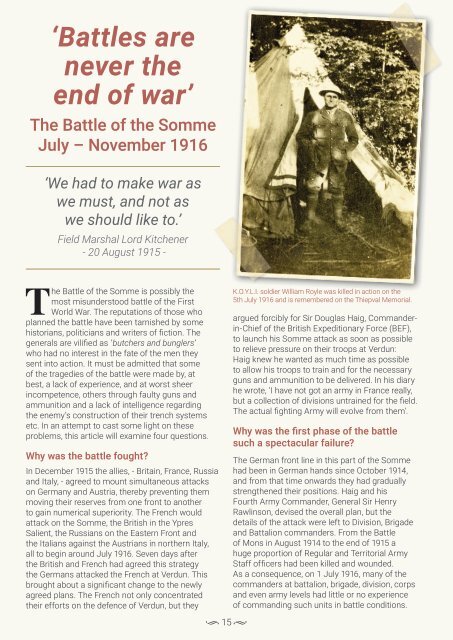Doncaster Times Issue 2 - November 2016
Doncaster Times is a biannual publication of articles and pieces researched and written by members of the public, volunteers and professionals. For its first four years, the magazine will feature articles about Doncaster during the First World War, to commemorate the centenary. The most recent publication is available in hard copy only, available to purchase from Doncaster Museum and Art Gallery, Doncaster Central Library and the Tourist Information Centre.
Doncaster Times is a biannual publication of articles and pieces researched and written by members of the public, volunteers and professionals. For its first four years, the magazine will feature articles about Doncaster during the First World War, to commemorate the centenary. The most recent publication is available in hard copy only, available to purchase from Doncaster Museum and Art Gallery, Doncaster Central Library and the Tourist Information Centre.
Create successful ePaper yourself
Turn your PDF publications into a flip-book with our unique Google optimized e-Paper software.
‘Battles are<br />
never the<br />
end of war’<br />
The Battle of the Somme<br />
July – <strong>November</strong> 1916<br />
‘We had to make war as<br />
we must, and not as<br />
we should like to.’<br />
Field Marshal Lord Kitchener<br />
- 20 August 1915 -<br />
The Battle of the Somme is possibly the<br />
most misunderstood battle of the First<br />
World War. The reputations of those who<br />
planned the battle have been tarnished by some<br />
historians, politicians and writers of fiction. The<br />
generals are vilified as ‘butchers and bunglers’<br />
who had no interest in the fate of the men they<br />
sent into action. It must be admitted that some<br />
of the tragedies of the battle were made by, at<br />
best, a lack of experience, and at worst sheer<br />
incompetence, others through faulty guns and<br />
ammunition and a lack of intelligence regarding<br />
the enemy’s construction of their trench systems<br />
etc. In an attempt to cast some light on these<br />
problems, this article will examine four questions.<br />
Why was the battle fought?<br />
In December 1915 the allies, - Britain, France, Russia<br />
and Italy, - agreed to mount simultaneous attacks<br />
on Germany and Austria, thereby preventing them<br />
moving their reserves from one front to another<br />
to gain numerical superiority. The French would<br />
attack on the Somme, the British in the Ypres<br />
Salient, the Russians on the Eastern Front and<br />
the Italians against the Austrians in northern Italy,<br />
all to begin around July 1916. Seven days after<br />
the British and French had agreed this strategy<br />
the Germans attacked the French at Verdun. This<br />
brought about a significant change to the newly<br />
agreed plans. The French not only concentrated<br />
their efforts on the defence of Verdun, but they<br />
K.O.Y.L.I. soldier William Royle was killed in action on the<br />
5th July 1916 and is remembered on the Thiepval Memorial.<br />
argued forcibly for Sir Douglas Haig, Commanderin-Chief<br />
of the British Expeditionary Force (BEF),<br />
to launch his Somme attack as soon as possible<br />
to relieve pressure on their troops at Verdun:<br />
Haig knew he wanted as much time as possible<br />
to allow his troops to train and for the necessary<br />
guns and ammunition to be delivered. In his diary<br />
he wrote, ‘I have not got an army in France really,<br />
but a collection of divisions untrained for the field.<br />
The actual fighting Army will evolve from them’.<br />
Why was the first phase of the battle<br />
such a spectacular failure?<br />
The German front line in this part of the Somme<br />
had been in German hands since October 1914,<br />
and from that time onwards they had gradually<br />
strengthened their positions. Haig and his<br />
Fourth Army Commander, General Sir Henry<br />
Rawlinson, devised the overall plan, but the<br />
details of the attack were left to Division, Brigade<br />
and Battalion commanders. From the Battle<br />
of Mons in August 1914 to the end of 1915 a<br />
huge proportion of Regular and Territorial Army<br />
Staff officers had been killed and wounded.<br />
As a consequence, on 1 July 1916, many of the<br />
commanders at battalion, brigade, division, corps<br />
and even army levels had little or no experience<br />
of commanding such units in battle conditions.<br />
•<br />
15 •




